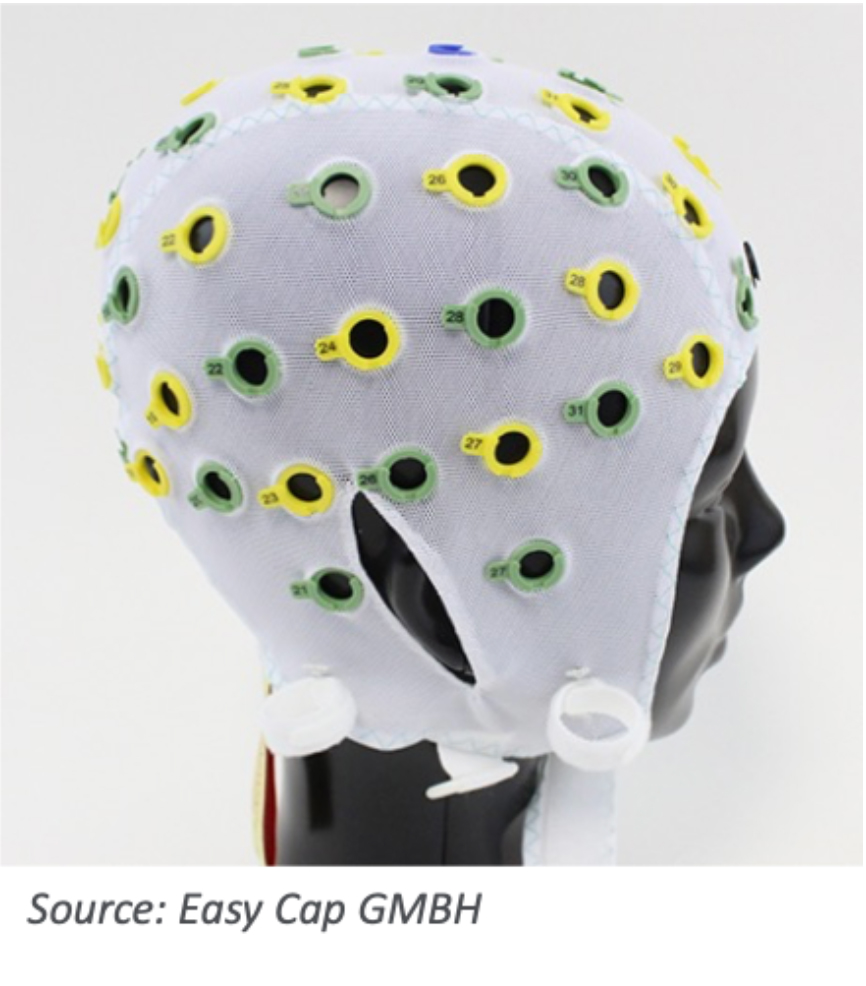A May 2023 study[1] of 15 second and third-graders in Haifa, Israel provides new evidence supporting the value of print. The study examined brain wave activity and concluded that reading on paper stimulated key parts of the brain more effectively than reading the same text on a screen. The study has important implications for the ability to focus, but it did not see any difference in comprehension between screen and print.
The study was funded by the Alon Fellowship for Outstanding Young Researchers, Council of Higher Education, Israel. To see the full study, visit https://www.ncbi.nlm.nih.gov/pmc/articles/PMC10194945/.
Brain Waves, Media, and the Ability to Focus
You might need a PhD to understand the actual study, but just imagine this: a person in a lab coat asks a 7-year-old child to sit down. They then place a special cap on the child’s head and fasten a strap under their chin. The head-worn device looks a bit like an old-fashioned ladies’ swimming cap, but instead of rubber flowers, it is covered with electrodes that are capable of reading brain waves. The child is then asked to read 2 age-appropriate 100-word text blurbs without illustrations. This is followed up by a set of 5 questions. The test is conducted once as text on paper and then a second time as text on screen (the order was randomized across the participants).

Figure 1: Easy Cap EEG Recording Cap
The children that partook in this study had been tested in advance to ensure that they had no neurological or developmental issues, and they were offered a gift valued at $25 for their trouble. The number of children in the study (15) was selected to afford an 80% level of accuracy.
The purpose of the study was to examine the differences in “brain activation” when reading from a screen compared to reading from a printed paper. The electroencephalogram (EEG) data that was collected via the electrode cap focused on two types of brain waves related to language, visual processing, and cognitive control. The researchers concluded that when reading from a printed paper, the children’s brains showed higher energy in high-frequency beta and gamma bands. When they read from a screen, meanwhile, their brains showed higher power in lower frequency alpha and theta bands. What in the world does this mean?
One important takeaway is that when there is higher power in the theta bands (as occurred when viewing text on a screen), it means that the person has challenges in allocating attention to a given task, such as reading. This is a fancy way of saying that it is harder to focus when reading on screen, even when there are no other distractions on the digital device. The second and third graders in this research had no other screen distractions during the test—though this is certainly not the case for the rest of us using smart phones and computers. The researchers use the term “screen inferiority” to describe the results of studies in which participants who read texts digitally performed worse than those who read printed texts.
The Results of the Study
The researchers went into this study with the following hypotheses:
- Participants reading on screen would show brain waveforms associated with lower attention allocation and mind wandering. The resulting research supported this hypothesis.
- Reading from a printed piece of paper would be accompanied by higher energy in higher frequency bands. This was also supported by the data.
- Brain wave activity will occur in areas associated with a “decreased performance in the attention task” (also known as daydreaming). This was supported by the data.
- The authors expected that reading on paper would result in higher reading comprehension scores than on-screen reading. This was not supported by the data. No significant differences in comprehension were found between screen and print reading.
To summarize, the study provides brainwave evidence that a child’s attention is overloaded when he or she is exposed to information on screens.
The Bottom Line
Though it is true that print comes out as the winner in this study, the win isn’t about comprehension. It is about the ability to focus. The authors note that other studies have shown that comprehension is better with print, but they admit that their study did not support this finding. The authors categorically state, “…our study did not find media effects on comprehension levels.” In other words, the children’s comprehension level was the same for paper and screen during this study.
The researchers admit that a study of young children reviewing very short written passages may not be the best way to understand the impact of paper versus digital on comprehension. Other studies, they point out, do show comprehension differences that tend to favor print.
I recommend that people read this study carefully before jumping to any conclusions about comprehension. In addition to some important findings on cognitive load and focus, the study also does an excellent job of summarizing other research that is happening in this area. These other studies can help shed some additional light on reading comprehension.
Source: Jim Hamilton, Consultant Emeritus at Keypoint Intelligence
Author bio: Jim Hamilton of Green Harbor Publications is an industry analyst, market researcher, writer, and public speaker. For many years, he was Group Director in charge of Keypoint Intelligence’s (formerly InfoTrends’) Production Digital Printing & Publishing consulting services. He has a BA in German from Amherst College and a Master’s in Printing Technology from the Rochester Institute of Technology.
- “Higher theta-beta ratio during screen-based vs. printed paper is related to lower attention in children: An EEG study” by Michal Zivan, Sasson Vaknin, Nimrod Peleg, Rakefet Ackerman, Tzipi Horowitz-Kraus. Edited by Wajid Mumtaz. ↩︎


